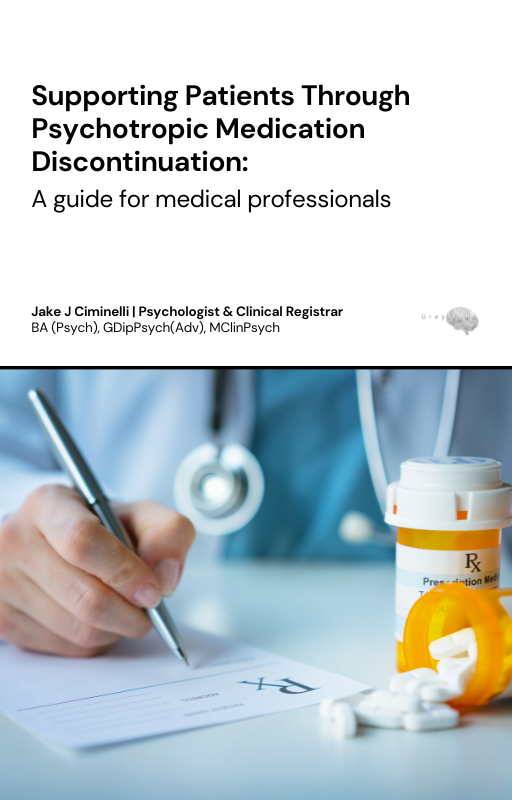 Image 1 of 1
Image 1 of 1


Supporting Patients Through Psychotropic Medication Discontinuation: A guide for medical professionals
Supporting Patients Through Psychotropic Medication Discontinuation (FREE)
A concise, evidence-based resource for clinicians navigating the complexities of psychiatric drug withdrawal.
This professional guide is designed for general practitioners, psychiatrists, psychologists, and other healthcare providers who support patients discontinuing psychotropic medications. Drawing on the latest research from Horowitz, Moncrieff, and others, this brief but powerful resource outlines the physiological realities of withdrawal syndromes—challenging outdated assumptions that withdrawal is short-lived or purely psychological.
Written by a clinical psychologist with experience in medication tapering and withdrawal support, this guide provides clear explanations, clinical cautions, and practical recommendations for safely guiding patients through discontinuation—without exacerbating symptoms or resorting to unnecessary polypharmacy.
A must-have primer for anyone committed to ethical, informed prescribing and collaborative patient care.
Inside, clinicians will find:
The neurobiological reality of withdrawal syndromes: receptor-level changes and CNS destabilisation
Key differences between true relapse and withdrawal symptoms—how to clinically differentiate them
A breakdown of why linear tapers fail due to the hyperbolic dose-response curve of most psychotropics
The gold-standard tapering method: reducing by 10% of the current dose every 4+ weeks
Risks of introducing new medications (e.g., benzos, antipsychotics) during withdrawal phases
Common withdrawal symptoms—including physical signs like brain zaps, nausea, and akathisia
Case for prioritising nervous system stability over fast reductions or substitution strategies
Clear, research-backed guidance clinicians can integrate into practice immediately
Supporting Patients Through Psychotropic Medication Discontinuation (FREE)
A concise, evidence-based resource for clinicians navigating the complexities of psychiatric drug withdrawal.
This professional guide is designed for general practitioners, psychiatrists, psychologists, and other healthcare providers who support patients discontinuing psychotropic medications. Drawing on the latest research from Horowitz, Moncrieff, and others, this brief but powerful resource outlines the physiological realities of withdrawal syndromes—challenging outdated assumptions that withdrawal is short-lived or purely psychological.
Written by a clinical psychologist with experience in medication tapering and withdrawal support, this guide provides clear explanations, clinical cautions, and practical recommendations for safely guiding patients through discontinuation—without exacerbating symptoms or resorting to unnecessary polypharmacy.
A must-have primer for anyone committed to ethical, informed prescribing and collaborative patient care.
Inside, clinicians will find:
The neurobiological reality of withdrawal syndromes: receptor-level changes and CNS destabilisation
Key differences between true relapse and withdrawal symptoms—how to clinically differentiate them
A breakdown of why linear tapers fail due to the hyperbolic dose-response curve of most psychotropics
The gold-standard tapering method: reducing by 10% of the current dose every 4+ weeks
Risks of introducing new medications (e.g., benzos, antipsychotics) during withdrawal phases
Common withdrawal symptoms—including physical signs like brain zaps, nausea, and akathisia
Case for prioritising nervous system stability over fast reductions or substitution strategies
Clear, research-backed guidance clinicians can integrate into practice immediately
